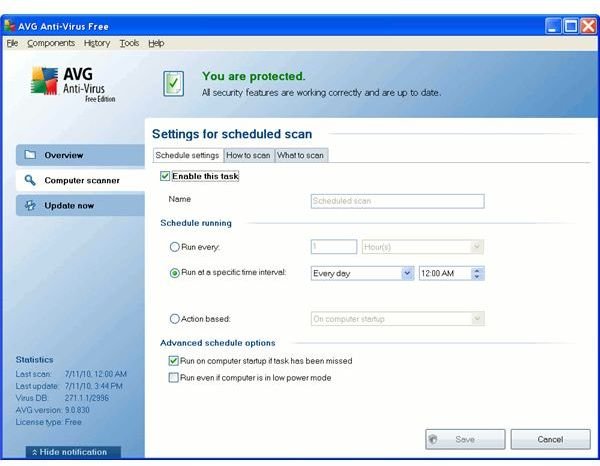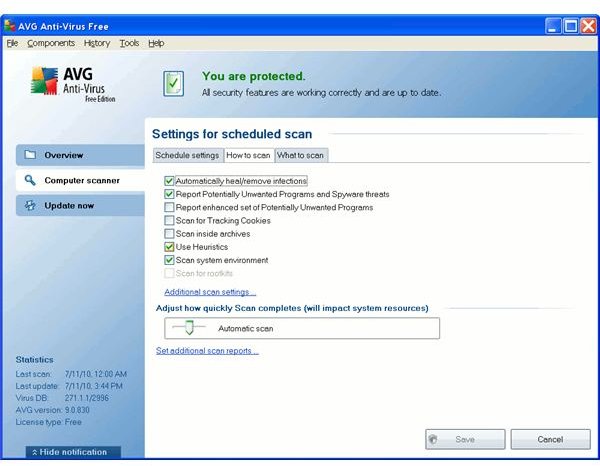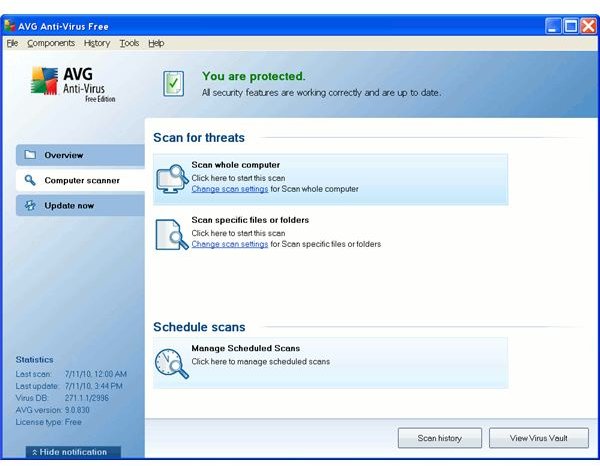Computer Troubleshooting - Computer Running Slow After AVG Installation
AVG Introduction
My love for AVG Free is pretty well known. I’ve already covered whether AVG Free is enough for your computer and when you should schedule AVG updates. I also have a fairly good guide for installing AVG. Therefore, it only makes sense to cover what you should do if you find your computer running slow after AVG installation.
I’ll try to cover just what might be causing the problem, help you fix it, and also cover how to easily disable AVG Free if you continue to have trouble with it.
Why Your Computer May Run Slowly After AVG Installation
This is actually pretty simple. AVG and AVG Free are resource hogs. They take up a surprising amount of CPU and RAM when they’re running their scans. Now, what’s probably happening is that you’re stuck with scheduled scans that they set by default. These should be set to run daily. These are full scans. A full scan takes a few hours when running at normal speed even on a good computer. The really big problem is that the scan doesn’t give much notice when it happens, just a popup in the bottom right corner that you might miss and a quick summary once it’s done. You might not even know that it’s happening, unless you just happen to mouse over the AVG symbol.
The worst part may be that the scan will just pause when you shutdown the computer. With poor timing, this can result in scans running whenever you’re on the computer. This is the most likely reason for your computer running slow after AVG installation.
There isn’t much else that could cause it. The resident shield shouldn’t eat up power and updates are fairly brief. They should only cause lag for a minute or so once a day. Chances are that the slowdown is just because of your scheduled scan.
The Quick Fix for AVG Slowdowns

Thankfully, the

fix couldn’t be much easier. You just have to make up your mind about scheduled scans. Open up your AVG antivirus program and click on the bar for Computer Scanner. Just stop the scan if one is in progress. Click on the button at the bottom for Scheduled Scans. You will then see when your next schedule scan is set to occur. Click the button for Editing the Schedule. You will now have a very big menu to tinker around with and set it based on your preferences.
The easiest step is to reflect on when you use your computer. If there is a time when you usually don’t use it (for example, primetime on weekdays when your favorite television shows are on), then just schedule it then and you’ll barely notice the slowdown. That’s probably the most practical option.
You can also click on the second tab, labeled How to Scan. This tab has a little slider that tells you how it is currently scanning. It should be set by default to Automatic Scan. You can set it to either Fast Scan or Slow Scan. Fast scan uses up all the system resources it can to help finish the scan quickly. This will make most computers very slow, however. If you aren’t using it, then it’s a good idea to give it a little extra juice. The slow scan is the one you might want to use.This restricts how many system resources that it can use. The scan will take a fair bit longer to complete, but it shouldn’t cause as much of a slowdown on your computer.
You can also click on the tab for What to Scan. By default, it should be set to scan the whole computer. This is a fairly good idea for ensuring your maximum security, but it might be too much for an older computer. You might want to have it scan specific folders, like your Windows Folders. This will make the scan take much less time.
Finally, you can probably just shut off scheduled scans and be fine. It’s a good idea to keep them on if you can, but most users probably aren’t going to risk a security breach everyday. If you can remember, just have the computer do a scan once a week, then you can safely shut it off. Just manually tell it to scan before you eat dinner or stop to read a book or watch TV. Schedules scans are there for convenience. If they’re slowing down your computer, then just shut it off.
These simple steps should be enough to help you if your computer is running slow after AVG installation. If none of these steps help, then you can follow the steps in my other guide to Disable AVG Free.
Screenshots courtesy of Aaron R from AVG.
